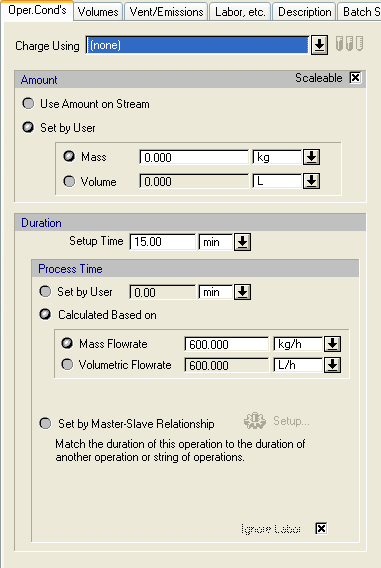

The following table shows a brief description of the variables appearing in this tab; for a detailed description of these variables, see Charge: Modeling Terminology. The table also displays their default values and their generally acceptable range. Note that due to how the variables are used in the modeling equations, the range of acceptable values may be further reduced; for more details, see Charge: Modeling Assumptions & Constraints.
|
Variable |
Default Value |
Range |
|
|
||
|
○ Charge Using Port / Stream |
<None> |
Any Input Port |
|
◙ Mass (kg) |
0.0 |
Positive |
|
◙ Volume (L) |
0.0 |
Positive |
|
○ Setup Time (min) |
15.0 |
Positive |
|
◙ Process Time (min) |
0.0 |
Positive |
|
◙ Mass Flowrate (kg/h) |
600.0 |
Positive |
|
◙ Volumetric Flowrate (L/h) |
0.0 |
Positive |
|
○ Ignore Labor? |
Yes |
Yes/No |
Symbol Key: ○ User-specified value (always input); ● Calculated value (always output); ◙ Sometimes input, sometimes output
The following list describes the available specification choices in this tab; for more details on how these are implemented, see Charge: Modeling Calculations.
•Charge stream...
You must always select a charge stream. The charge stream must be one of the input streams of the procedure that this operation is participating AND it must be a process input (i.e. intermediate streams are not allowed as charge streams – to introduce material into a procedure from an intermediate stream, you must use a Transfer-In Operation). Furthermore, a procedure input stream can only be used by one charge operation (i.e. charge operations cannot share input streams). You can specify the mass / volume to be charged either from the operation or from the stream interface.
•Charge amount...
The charge amount can either be set directly on this dialog (so it becomes part of the operation’s set of specifications) or it can be set directly on the charge stream (attached to the charge port chosen on this dialog).
•Duration options...
The duration of the operation can be calculated by the following ways:
a) Set directly the user
b) Calculated based on a user-specified mass or volume charge rate, or
c) Tied up to another operation or operation sequence by exploiting the Master-Slave relationship. If you introduce a master-slave relationship, the program will match the setup time, the process time and the turnaround time of this operation (the ‘slave’) with the corresponding times of the reference operation (the ‘master’ operation). For more details on how to setup a master-slave relationship, see The Scheduling Tab.
● Pull In